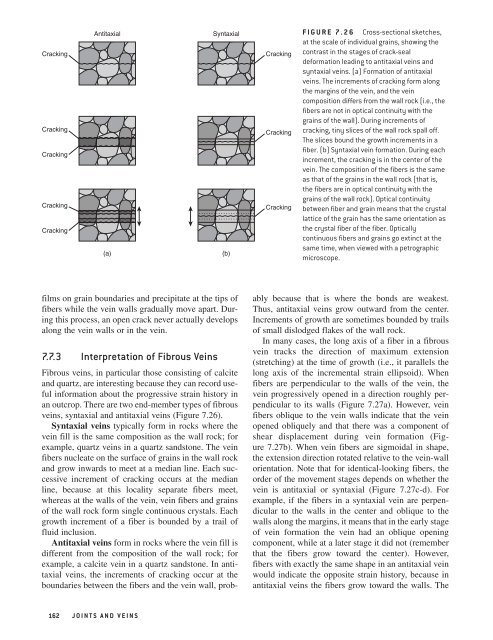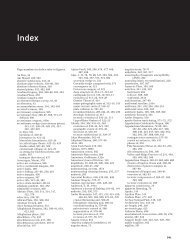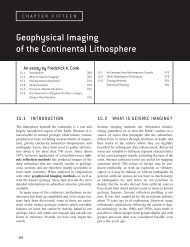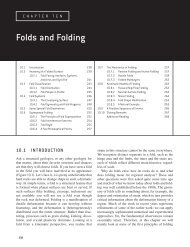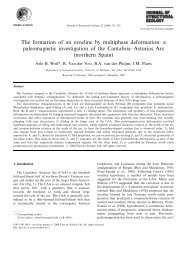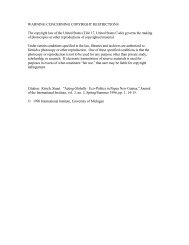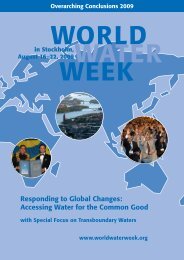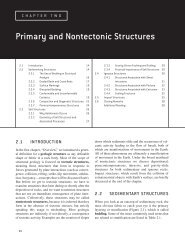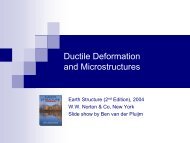Joints and Veins - Global Change
Joints and Veins - Global Change
Joints and Veins - Global Change
- No tags were found...
Create successful ePaper yourself
Turn your PDF publications into a flip-book with our unique Google optimized e-Paper software.
2917-CH07.pdf 11/20/03 5:11 PM Page 162CrackingCrackingCrackingCrackingCrackingAntitaxial(a)Syntaxial(b)CrackingCrackingCrackingFIGURE 7.26 Cross-sectional sketches,at the scale of individual grains, showing thecontrast in the stages of crack-sealdeformation leading to antitaxial veins <strong>and</strong>syntaxial veins. (a) Formation of antitaxialveins. The increments of cracking form alongthe margins of the vein, <strong>and</strong> the veincomposition differs from the wall rock (i.e., thefibers are not in optical continuity with thegrains of the wall). During increments ofcracking, tiny slices of the wall rock spall off.The slices bound the growth increments in afiber. (b) Syntaxial vein formation. During eachincrement, the cracking is in the center of thevein. The composition of the fibers is the sameas that of the grains in the wall rock (that is,the fibers are in optical continuity with thegrains of the wall rock). Optical continuitybetween fiber <strong>and</strong> grain means that the crystallattice of the grain has the same orientation asthe crystal fiber of the fiber. Opticallycontinuous fibers <strong>and</strong> grains go extinct at thesame time, when viewed with a petrographicmicroscope.films on grain boundaries <strong>and</strong> precipitate at the tips offibers while the vein walls gradually move apart. Duringthis process, an open crack never actually developsalong the vein walls or in the vein.7.7. 3 I nter pr e tation of Fi brous Vei nsFibrous veins, in particular those consisting of calcite<strong>and</strong> quartz, are interesting because they can record usefulinformation about the progressive strain history inan outcrop. There are two end-member types of fibrousveins, syntaxial <strong>and</strong> antitaxial veins (Figure 7.26).Syntaxial veins typically form in rocks where thevein fill is the same composition as the wall rock; forexample, quartz veins in a quartz s<strong>and</strong>stone. The veinfibers nucleate on the surface of grains in the wall rock<strong>and</strong> grow inwards to meet at a median line. Each successiveincrement of cracking occurs at the medianline, because at this locality separate fibers meet,whereas at the walls of the vein, vein fibers <strong>and</strong> grainsof the wall rock form single continuous crystals. Eachgrowth increment of a fiber is bounded by a trail offluid inclusion.Antitaxial veins form in rocks where the vein fill isdifferent from the composition of the wall rock; forexample, a calcite vein in a quartz s<strong>and</strong>stone. In antitaxialveins, the increments of cracking occur at theboundaries between the fibers <strong>and</strong> the vein wall, probablybecause that is where the bonds are weakest.Thus, antitaxial veins grow outward from the center.Increments of growth are sometimes bounded by trailsof small dislodged flakes of the wall rock.In many cases, the long axis of a fiber in a fibrousvein tracks the direction of maximum extension(stretching) at the time of growth (i.e., it parallels thelong axis of the incremental strain ellipsoid). Whenfibers are perpendicular to the walls of the vein, thevein progressively opened in a direction roughly perpendicularto its walls (Figure 7.27a). However, veinfibers oblique to the vein walls indicate that the veinopened obliquely <strong>and</strong> that there was a component ofshear displacement during vein formation (Figure7.27b). When vein fibers are sigmoidal in shape,the extension direction rotated relative to the vein-wallorientation. Note that for identical-looking fibers, theorder of the movement stages depends on whether thevein is antitaxial or syntaxial (Figure 7.27c-d). Forexample, if the fibers in a syntaxial vein are perpendicularto the walls in the center <strong>and</strong> oblique to thewalls along the margins, it means that in the early stageof vein formation the vein had an oblique openingcomponent, while at a later stage it did not (rememberthat the fibers grow toward the center). However,fibers with exactly the same shape in an antitaxial veinwould indicate the opposite strain history, because inantitaxial veins the fibers grow toward the walls. The162 JOINTS AND VEINS


